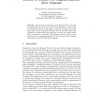343 search results - page 26 / 69 » Automatic Learning for Semantic Collocation |
CATE
2004
13 years 8 months ago
2004
The role of assessment and evaluation has recently changed in a way which will have fundamental consequences in applying information and communication technologies (ICTs) to analy...
CSL
2002
Springer
13 years 7 months ago
2002
Springer
A spoken language generation system has been developed that learns to describe objects in computer-generated visual scenes. The system is trained by a `show-and-tell' procedu...
FIMH
2009
Springer
13 years 5 months ago
2009
Springer
Cardiac magnetic resonance (MR) imaging has advanced to become a powerful diagnostic tool in clinical practice. Automatic detection of anatomic landmarks from MR images is importan...
ER
2006
Springer
13 years 11 months ago
2006
Springer
One of the main drawbacks of the Semantic Web is the lack of semantically rich data, since most of the information is still stored in relational databases. In this paper, we presen...
CICLING
2008
Springer
13 years 9 months ago
2008
Springer
We investigate the effect of encoding additional semantic and syntactic information sources in a classification-based machine learning approach to the task of coreference resolutio...

